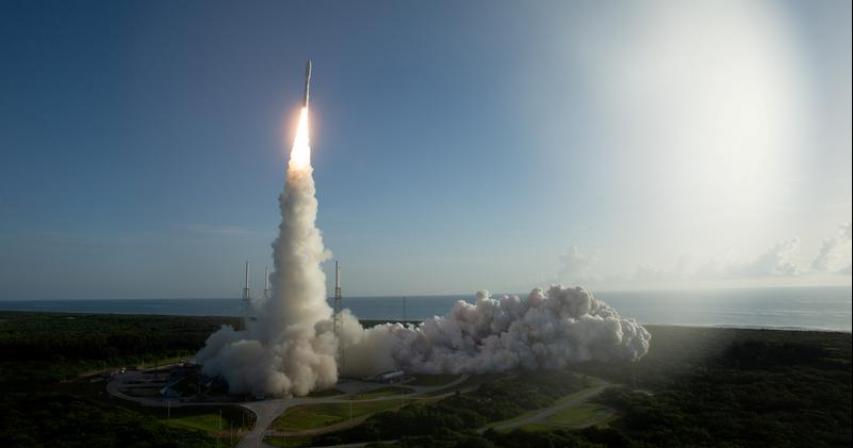NASA rover Perseverance hurtles toward historic landing attempt on Mars
- 5 years ago

NASA’s Mars rover Perseverance hurtled into the final stretch of its seven-month journey from Earth en route to a nail-biting landing attempt Thursday on an ancient, alien lake bed, where scientists hope to find signs of fossilized microbial life.
Perseverance, the most advanced astrobiology lab ever flown to another world, was headed for a self-guided touchdown inside a vast, rocky basin called Jezero Crater at the edge of a remnant river delta carved into the red planet billions of years ago.
Engineers at NASA’s Jet Propulsion Laboratory near Los Angeles hope to receive confirmation of the landing, and possibly a first image from the rover, shortly after its arrival, set for 12:55 p.m. PST (2055 GMT). Those transmissions will be relayed to Earth from one of several satellites already in orbit around Mars.
What makes Jezero Crater’s terrain - deeply etched by long-vanished flows of liquid water - so tantalizing to scientists also makes it especially treacherous as a landing site.
“It’s full of the stuff that scientists want to see but stuff that I don’t want to land on,” Al Chen, head of JPL’s descent and landing team, told reporters on Wednesday.
Getting Perseverance to its destination in one piece after its 293-million-mile journey, he added, is far from assured.
The multi-stage spacecraft, streaking into the Martian atmosphere at 12,000 miles per hour, must perfectly and swiftly execute a complex series of self-guided maneuvers to slow its descent, avoid myriad surface hazards and plant itself gently upright on all six wheels.
The seemingly far-fetched sequence includes a perilous parachute deployment at supersonic speed and a rocket-powered “sky crane” designed to detach from the entry capsule, fly to a safe landing spot and lower the rover on tethers, before zipping off to crash a safe distance away.
The entire process is set to unfold in a heart-pounding interval NASA engineers half-jokingly refer to as the “seven minutes of terror.”
Because it takes radio waves 11 minutes to travel one way between Mars and Earth, the SUV-sized rover will have already reached the Martian surface - intact or not - by the time its atmospheric entry signal is received at mission control.
NASA scientists describe Perseverance as the most ambitious of nearly 20 U.S. missions to Mars dating back to a 1965 Mariner fly-by.
Larger and packed with more instruments than the four Mars rovers preceding it, the latest mobile robotic probe would build on previous discoveries that the fourth planet from the sun was once warmer, wetter and possibly hospitable to life.
The primary objective of Perseverance’s two-year, $2.7 billion endeavor is to search for signs of microbes that may have flourished on Mars some 3 billion years ago, about the time life was emerging on Earth.
Scientists hope to find biosignatures embedded in samples of ancient sediments that Perseverance is designed to extract from Martian rock for analysis back on Earth - the first such specimens ever collected by humankind from another planet.
Two future missions are planned to retrieve the samples and return them to NASA in the next decade.
Perseverance’s payload also includes demonstration projects that could help pave the way for eventual human exploration of Mars, including a device to convert the carbon dioxide in Mars’ atmosphere into pure oxygen.
The box-shaped tool is the first built to extract a natural resource of direct use to humans from an extraterrestrial environment, according to Lori Glaze, director of NASA’s planetary science division. It would prove invaluable for future life support on Mars and for producing rocket propellant to fly astronauts home.
Another experimental prototype carried by Perseverance is a miniature helicopter designed to test the first powered, controlled flight of an aircraft on another planet. If successful, the 4-pound whirlybird could lead to low-altitude aerial surveillance of distant worlds, JPL officials said.
Should it safely land, Perseverance will have company elsewhere on the red planet. Its immediate predecessor, the rover Curiosity, which landed in 2012 and has far outlived its design life, remains in operation for NASA, as does the stationary lander InSight, which arrived in November 2018 to study the deep interior of Mars.
The United States is hardly alone in its fascination with Mars. Just last week, separate probes launched by the United Arab Emirates and China reached Mars orbit. NASA has three Mars satellites still in orbit, along with two from the European Space Agency.
Reporting by Steve Gorman in Los Angeles. Editing by Gerry Doyle / REUTERS
Comments